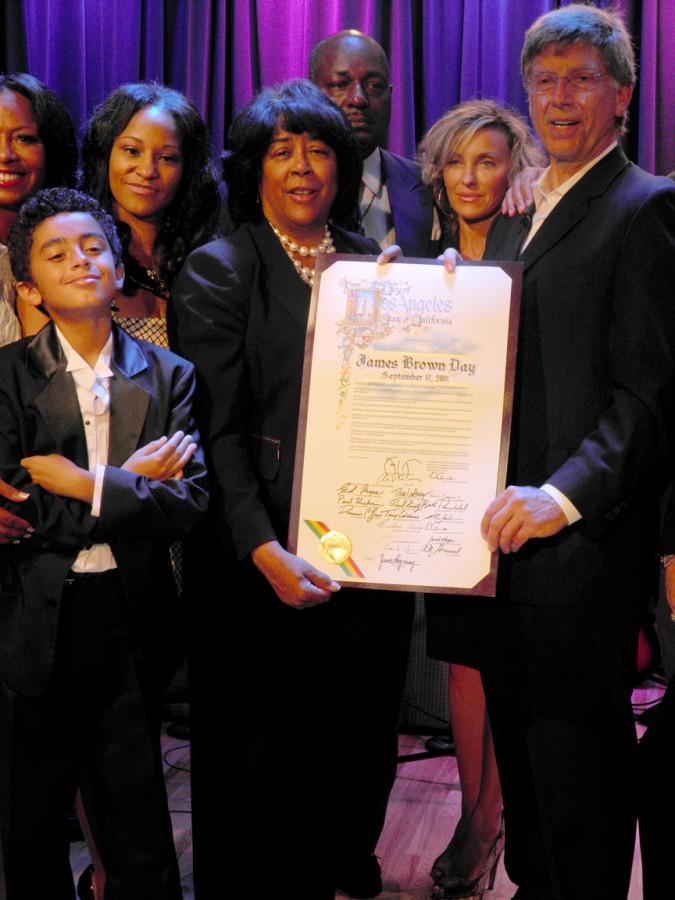The “Say it Loud! The Genius of James Brown” exhibit features 40 years of the Godfather of Soul’s influential career life, times and music in a flashy whirlwind of soul and funk. For newlisteners to Brown’s music, the exhibit offers a wide glimpse into Brown’s style and impact on music and American culture.
Born in South Carolina, James Brown was an influential musician who had a massive impact onmusic from the time he started performing to this day. Known as “The Hardest Working Man InShow Business” and “Mr. Dynamite,” Brown was known for his dedication to his work, hismoves and his sociocultural impact across the United States.
Visitors are treated with a glance into Brown’s hectic show life. Brown was known for performingwith edgy, outlandish clothing, from bell-bottoms to denim vests to his trademark capes. Ondisplay are some pieces of Brown’s performance wardrobe, including one of Brown’s early capes from when he was first performing his R&B hit, “Please, Please, Please,” and a custom jacket that Brown wore when he danced with Michael Jackson in the 2003 Black Entertainment Television Awards.
An array of Brown’s outfits from his time with the Famous Flames to his last performances is featured on a backdrop of flyers for Brown’s shows.Also on display are Brown’s handwritten lyrics to unreleased songs, with lyrics such as “Listen -people, listen / While I tell you about my baby / Treats me – fine and dandy / She’s my candy -love my baby” and “Stand up sway and shake your hips / Better be ready for soulful trip / Takeyour partner head ‘em on / This cool foot work is mighty strong.”
James Brown’s musical contributions created waves in the music industry that continue toinfluence contemporary music. Since his death in 2006, Brown is credited with being the mostsampled musician in the industry, with artists from Michael Jackson to The Rolling Stones toTupac Shakur having sampled his works in their music or been influenced by his compositions.
“He sung soul music because he sung from soul,” said Deanna Brown, daughter of James Brown. “Any young, talented musician needs to know that because that’s where the best musiccomes from – your soul, from within yourself.” Brown memorabilia is also on display – concert tickets, rare photographs from his performances and more. The exhibit has LP’s of Brown’s “Don’t Be a Dropout” and “Say It Loud – I’m Black andI’m Proud,” two of his socially conscious pieces.
Also on display is a letter Brown wrote to South Carolina’s Department of Parole and Community Corrections, calling for the release of a prisoner in 1983. His singles “Don’t Be a Dropout” and “King Heroin” promoted to youth staying in school and avoiding drugs, respectively. Brown also donated money to dropout prevention programs, which Lyndon B. Johnson recognized him for.
Brown released the single “I’m Black and I’m Proud” in1968 following the assassination of Martin Luther King Jr., which later became a key piece of the civil rights movement. Brown is also credited with preventing riots after King’s assassination byperforming in Boston and having the concert broadcast throughout Boston.
In addition, the walls are lined up with audiovisual booths that portray Brown’s influence onsociety and music. One booth chronicles the role Brown’s music had in preventing riots after Martin Luther King’s assassination, another contains interviews of artists who worked with orused Brown’s music as inspiration, and one gives a quick overview of his work.
Accompanying the booths are duo-chromatic prints of Brown on and off stage. Brown’s advocacy towards social causes such as racial equality, the importance of school and drug abuse left a lasting impact on society. Brown’s social works helped influence a generation and continue to shape future generations to this day.
“Without James Brown this world would not be the same place it is today,” said Tami RaeBrown, James’ widow. “James Brown changed the world of music, the world as we know it, really – giving people a voice and letting people know that they can be proud of themselves nomatter who they were, that it wasn’t about black or white, it’s about right – that’s what he stood for. We need to instill that in everybody.”
Near the edge of the exhibit is a “boogie booth” where visitors stand on a multicolored lighted disco floor and learn moves such as the Mashed Potato and the Camel Walk from James Brown himself via an instructional video in front of the dance floor. Brown’s moves influenced a whole new generation of dance – traces of Brown’s footwork can be seen in moves in modern breakdance and hip-hop.
In short, the exhibit wraps up Brown’s historical and musical significance in an afternoon anddoes it well for those with little to no background knowledge of Brown’s music. For those alreadyin tune with his rhythm and times, the exhibit portrays an unseen glimpse of Brown’s life and music as well as his contributions to society, both in the U.S. and worldwide.
The “Say it Loud! The Genius of James Brown” exhibit will be displayed at the Grammy Museumat the LA Live through January 22, 2012. The Grammy Museum is located on 800 W. OlympicBlvd., Los Angeles, CA 90015. Students pay $11.95 to enter with a valid ID, and regularadmission is $12.95. The museum opens from 11:30 a.m. to 7:30 p.m. on Mondays throughFridays and at 10 a.m. to 7:30 p.m. on Saturdays and Sundays.


